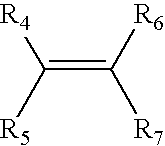Method for Generating Free Radical Capable Polymers Using Tin or Silicon Halide Compounds
a free radical capable and polymer technology, applied in the direction of tin organic compounds, organic chemistry, organic compounds, etc., can solve the problem of poor impact strength of brittle resins
- Summary
- Abstract
- Description
- Claims
- Application Information
AI Technical Summary
Benefits of technology
Problems solved by technology
Method used
Image
Examples
example 1
[0061]4.4 lbs of a dry blend of 21.8% 1,3-butadiene in technical grade hexane was charged to a 1-gallon stainless steel reactor under a N2 blanket 4.2 mmol of n-butyl lithium (nBuLi) was charged and the polymerization was allowed to proceed for 5.0 hours at 125-140° F. 0.42 mmol of the vinyl modifier 2,2-di(tetrahydrofuryl)propane and 5.4 mmol of the end-capper 1.1-diphenylethylene were added at 125° F. Immediately an orange-red color was developed. After 1 hour, three samples were collected in 700 ml crown-capped, N2 purged bottles. Bottle No. 1 containing 329.6 g of polymer cement was treated with 6 mmol isopropanol (N2 purged) (an excess). Bottle No. 2 containing 332.8 grams of cement (polymer in solvent) was treated with 0.13 mmol of SiCl4. Bottle No. 3 containing 334.0 grams of cement was treated with 0.16 mmol of dichlorodiphenylsilane. The bottles were placed in a 50° C. water bath for 18 hours. The cements were coagulated in isopropanol with the butylated hydroxytoluene anti...
example 2
[0063]Synthesis of tapered 1,3-butadiene / styrene copolymer: To a 1-gallon stainless steel reactor under a N2 blanket was charged 3.0 lbs. of 21.5% 1,3-butadiene in technical grade hexane, 3.0 lbs. of technical grade hexane and 67 g of 33% styrene in hexane. All solvents were dried to less than 5 ppm water and oxygen free. 64.7 mmol of nBuLi was charged to the reactor and polymerization was allowed to proceed for 5 and ⅓ hours at 123-127° F. 308 grams of a control sample was taken and live cement was terminated with isopropanol. A second 308 gram sample was also taken. It was calculated that a maximum of 51.3 mmol of carbon-bound lithium was still present in the reactor, 50.4 mmol of 1,1-diphenylethylene and 16 mmol of the vinyl modifier 2,2-di(tetrahydrofuryl)propane were added to the reactor and allowed to react for 2.75 hours at 125° F. and a further 16 hours at ˜70° F. A sample was taken for analysis and it was determined that 23.6% of the 1,1-diphenylethylene remained unreacted....
PUM
| Property | Measurement | Unit |
|---|---|---|
| length | aaaaa | aaaaa |
| transparent | aaaaa | aaaaa |
| particle size | aaaaa | aaaaa |
Abstract
Description
Claims
Application Information
 Login to View More
Login to View More - R&D
- Intellectual Property
- Life Sciences
- Materials
- Tech Scout
- Unparalleled Data Quality
- Higher Quality Content
- 60% Fewer Hallucinations
Browse by: Latest US Patents, China's latest patents, Technical Efficacy Thesaurus, Application Domain, Technology Topic, Popular Technical Reports.
© 2025 PatSnap. All rights reserved.Legal|Privacy policy|Modern Slavery Act Transparency Statement|Sitemap|About US| Contact US: help@patsnap.com

